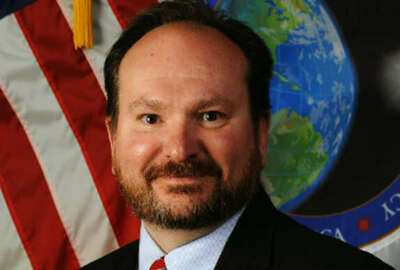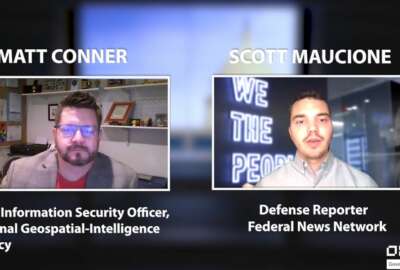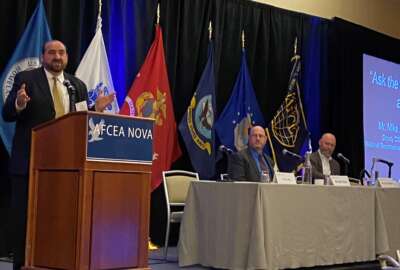

The National Geospatial Intelligence Agency is trying to see circles. That is, it wants satellites to have the ability to identify circles.
Best listening experience is on Chrome, Firefox or Safari. Subscribe to Federal Drive’s daily audio interviews on Apple Podcasts or PodcastOne.
The National Geospatial Intelligence Agency is trying to see circles. That is, it wants satellites to have the ability to identify circles. If you think that sounds easy, you’re missing a major challenge for artificial intelligence in the geospatial world. With details of the challenge competition and why it matters, the NGA’s GEOINT capabilities integration officer Jack Brandy joined Federal Drive with Tom Temin.
Interview transcript:
Tom Temin: Mr. Brandy, good to have you on.
Jack Brandy: It’s great to be on. Thank you for inviting us.
Tom Temin: So you are trying to reach out to the scientific, I guess, an academic community to do what exactly?
Jack Brandy: That’s a very good question. So really, what we’re trying to aim for is some very clever techniques to find circular shape features in satellite imagery. And the circular shape features can cover really just about any kind of object — it can go from hibbett, agricultural areas to oil storage tanks. And so we’re trying to find a really clever way to find an algorithm that can find all sorts of these features.
Tom Temin: I guess I’ll make an analogy here with robotics, because robots are capable of doing a simple thing really fast, a million times, which people are not, but they really have a hard time walking, which people find easy. So the human eye can see a circle, no problem, but apparently eyeballs up in space that are electronic, it cannot.
Jack Brandy: It can certainly be challenging in any kind of processing algorithm to find those kind of circular shaped features. But more importantly for us, one of the difficulties with any kind of computer vision or AI is that you have to have a large volume of data to train an algorithm to find those particular objects. And so we thought it would be more interesting to kind of flip the script and say instead of trying to find tons and tons of examples of an object, let’s just find one shape that represents many, many different kinds of objects.
Tom Temin: So is the objective here, not so much to find circles, but to learn how artificial intelligence can aid computer vision for whatever the problem might be in the future?
Jack Brandy: Exactly. So really the goal is trying to find something that’s a little bit more general purpose that can be used in kind of a more complex processing pipeline. So we start with something, say finding circles. And in the Navy, the next step in the processing is an algorithm that identifies a specific shape from our Pacific objects. So maybe it identifies the agriculture areas for storage tanks, after we’ve identified that it’s circular.
Tom Temin: Sure, so you’re using circles as the testbed for this because they’re more numerous on the ground to say than triangles.
Jack Brandy: Exactly. They’re more numerous. But more importantly is that triangles and squares tend to be shapes, they’re kind of like composite shapes, I’ll call it. So if you took a example of a very large building it will be made up of many, many different kinds of triangles and squares that kind of build that feature. Circular shape objects, though, tend to be just that, they’re just one circle. So we felt that would be a good starting for this kind of challenge.
Tom Temin: Okay, and how does this challenge structured? I mean, who do you expect to participate in this? And what would they have to do to give you a credible entry here?
Jack Brandy: It’s open to the public. So pretty much anybody can participate. And we have the full eligibility and participation details on challenge.gov. Really, it just comes down to as long as enough federal entity are already paid by the federal government for this kind of work, just register on the site, and you’re good to go. And for people participating, what we’re really hoping is that they submit two things. One, of course, is an algorithm that can basically output what we call a shape file that has all the circles in the test images. And then the next kind of deliverable is a white paper that simply describes the approach they took.
Tom Temin: And are you supplying the contestants with a sample image or set of images to work on?
Jack Brandy: Yes, we are providing, as part of this challenge a set of about 20,000 examples so that people can use it to train your algorithm, test it, and then we’ll use the rest to kind of evaluate solutions.
Tom Temin: And with satellites, having the ability to determine what is a circle through artificial intelligence — how will that type of capability benefit the NGA and the intelligence officers and I guess the geospatial field in general, because from satellite imagery now, humans can easily identify circles?
Jack Brandy: So really, you know at the National Geospatial Intelligence Agency, of course, everything on earth can be measured in space and time. And the intel is usually gleaned from careful analysis of satellite imagery. And a very simple example, you can imagine this is a real world game of finding the difference between two images. However, there’s no answer sheet to check. And a lot of times those details are incredibly so. When we support first responders there are natural disasters or military services that are in operations or even the nation’s leaders and making key decisions — the timing, accuracy of this image analysis is crucial. So what we’re hoping is with the help of AI, we can speed up the time from image to decision.
Tom Temin: Because I can imagine a situation where you are examining imagery or the satellites are gathering imagery when it would be important to know, not only is there a circle, but is that circle the opening to a missile silo? Is it a storage tank, as you mentioned? Or is it a crop circle or something else entirely?
Jack Brandy: Exactly. So identifying, not only just circles, kind of helps feed to our analysts who might be interested in kind of the circles that might be of a certain shape or size, and helps them zero in on those features to say, okay, is this something that’s important? Is there something I need to do extra for this particular shape?
Tom Temin: Because if I was thinking, like, say, North Korea, and I knew you had this capability, I would just put the nice round missile silo, I would make it the same shape as a crop circle, I would plant 50 crop circles and put it in position A7.
Jack Brandy: That would certainly be a clever way to do it.
Tom Temin: The point is, are you looking for the capability to go further into circles and saying, well, this circle looks more like this thing? Because it’s perfectly smooth around the edges, and that one has a couple of jagged parts. So therefore, it may not be something that we care about.
Jack Brandy: No, we feel that really, that’s where our human analysts are most suited. They have the expertise, and they have the knowledge to make that kind of determination. We feel like the algorithm should really just help analysts kind of zoom in on those particular areas. But we’re not worried about the algorithm kind of solving all the questions.
Tom Temin: Yeah. So really a classic application of artificial intelligence to boost human productivity. Alright, and what are the parameters here? When are things due? When will you make awards? And how much can the awardee receive and then what happens after the winners are chosen?
Jack Brandy: So we should be wrapping up the challenge expecting submissions by November 3. So it’s a bit of a quick turnaround. It’s up to a $50,000 purse, split over five awards, so first, second, third, fourth, and fifth. The first place being I believe it’s $20,000. And we should expect really about November 5, the winning solution to be identified.
Tom Temin: Jack Brandy is the GEOINT capabilities integration officer at the National Geospatial Intelligence Agency. Thanks so much for joining me.
Jack Brandy: Thank you for having us.
Copyright © 2025 Federal News Network. All rights reserved. This website is not intended for users located within the European Economic Area.
Tom Temin is host of the Federal Drive and has been providing insight on federal technology and management issues for more than 30 years.
Follow @tteminWFED



